
|
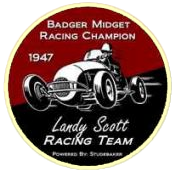
|
By: Landy Scott This was the late
30's and midget racing was at it's peak. Tracks were
featuring midgets from Wally Zale, "The Chicago Cyclone" and his green #9 midget were frequent visitors to "Victory Lane", once winning an amazing 14 of 16 feature starts, nine in a row. He won 46 features during the 1936 season and four years later won 69 main events.
On one particular day it was not running at all when a fellow came up to me and said, “You need help!” I replied, “Boy, I sure do.” After he worked on my car for about a half hour, I went out and won my first heat race. The fellow turned out to be George Welch, who from that time on was to be my mechanic and me, his driver. We made a deal for me to drive his car, an old 4 cylinder Plymouth, number 17. It turned out to be a little better than my number 9, but not by much. I drove the car the next day and placed fourth in the feature race.
George got a rail frame and an old Model T front end, a rear end from an old race driver by the name of Ted Rosston (South Milwaukee), and a body, then started to put everything together. He picked up a 1941 Studebaker Champion engine and worked on porting and relieving it for two weeks every night. Then he put in Pontiac exhaust valves and Dodge valve springs. He sleeved it down and put in 1939 Studebaker rods, which were shorter than those used in 1941. He used Jahns pistons and a Plymouth carburetor. Everything else was stock Studebaker. We painted the car
maroon and cream with the number 17. The colors and number
design was borrowed We decided that for the first three races we would take it easy and feel out the new car. Here are the results. First race: Seventh fastest time, second in the heat race and fourth in the feature. Second race: fourth fastest time, first in the heat race, leading the feature when the fuel pump gave out (we changed to an electric fuel pump after that). Third race: fourth fastest time, eleventh in the heat race and third in the feature. By the fourth race we were ready to go and see what we could do. No holding back! That was at Darlington, Wisconsin on a half-mile track. I had fourth fastest time in qualifying and first in my heat. In the feature race John Dietz and I engaged in a spectacular duel for first place, when on the seventh lap we tangled and went through the fence. Billy Johnson went on to win. At one point during the 1947 season, we won six (6) consecutive feature races, at six different tracks, a Badger record that still stands today. We went on to win the 1947 Badger Midget Auto Racing Association’s Championship. *** Landy won $3,588.00 in prize money in 1947, competing in 46 different events.
In 1948, with a new Kurtis Kraft body, we raced in five special “Musketeer Races.” These races were held over five consecutive weeks at various tracks, between the top four drivers. The drivers consisted of: Chet Morris, Kelly Peters, Billy Johnson and me. I won all five races. During the 1948 season, on June 21st (my birthday), I was burned over 40% of my body, when a water hose broke during a race at Sun Prairie. During the weekend of July 2 - 4, against the orders of my doctor, I was back in my race car. My crew had to remove the steering wheel from the car and lift me in, because I couldn't bend my legs enough to get in under my own power. Between races I would remain in the car, as the pain was too great to get in and out. We won 2 of the 3 Feature races. I had a practice of staying in second until the last lap and then pass for the lead, but this time I guessed wrong and missed the win by two feet. George asked my what was wrong and I told him that the car just lost power. George tore the car apart trying to figure out what went wrong, but found nothing. I finally admitted that it was my misjudgment that cost us the race. George laughed and that became a running joke. Later that year, Chet Morris was driving a Kurtis-Kraft midget with a Granatelli engine. George offered to help him. He took an old engine that Chet had lying around and put it together for him. Chet and I went out and finished first and second in the next three races. The engine was better than the one that Chet had paid Granatelli $1,200.00 for (remember what $1,200.00 was worth in 1948). One of my most
notable memories of the “Welch Stude” was a 50-lap
race at the famous Milwaukee Mile in 1947. This was one of
the premier races of the year, which drew the top A note from Richard Welch, son of George Welch: "You two were the fastest class B [stock blocks] midget around in 1947 & 1948 & running on a very limited budget is all the more amazing. I can still remember the late Bill Vukivich after being beat by you in a heat race, I believe at Wisconsin State Fair Park, he came running over to demand to know what kind of engine the Welch Special was running. He couldn't believe he had been beat by class B midget. When my father showed him that it was a Studebaker he really couldn't believe it. The secret was not horsepower but torque with a driver smart enough to use it. Landy, you knew how to manage it. You had to know how to use a light progressive pressure on the gas pedal. That is not how you drove a Ford V-8 60, it was "pedal to the metal" as they say." George Welch could have been the best racing mechanic in the racing business if he had really wanted to. He was a kind and gentle man. He was thoughtful and patient to everyone that he met. He was one of the greatest guys that it was my pleasure to know. I miss him, and his subtle sense of humor very much. Even after we parted ways after the 1948 season, he built me a new engine for my car. He put on three Riley carburetors and tuned it to run on pure alcohol, which was a first at the time. The car ran the entire season without any mechanical problems. We won races too! After parting ways, George ran one more season, before selling his car at the end of the 1949 season. In 1949, I bought my own car, a green #9 and drove it for two years. In 1950, Pete Pavasil bought the "17" for his brother Al to drive. Al flipped it on the first lap of qualifying of his first race. The car landed on Pavasil, breaking his back. I drove the car for the remainder of the season without much success. I also tried my
hand behind the wheel of "Stock cars" during the 1949
season. Stock car racing was
In 1956 we felt the "17" needed an update, so we bought a Kurtis Kraft chassis from Johnny Pawl, that was previously driven by Tony Bettenhausen, Sr. Tony had flipped the car during a race at Soldier Field, Chicago. It had a broken front axle, no steering and no rear end. We reinstalled the Studebaker Champion engine, steering gear and gear box from the original "17." We installed a "quick change" rear end. By this time we were running a magneto and fuel injection. I drove that car until 1961, when I retired from racing. I sold the car to Pancho Pinilla, of Chicago, Illinois for $2,250.00 and bought land on Green Bay on which I built a cottage....but, that's another story. Pancho removed the Studebaker and installed a Ford. The car exchanged hands for a number of years before being stripped for parts and moth balled in someone’s garage. I hope you enjoyed my story. It was a great career with many beautiful memories. Landy Scott ***
Read
the rest of the story on the "The
Rescue of #17" and
"#17
Midget Today"
pages. ***
|
|
Web Design By: Dan Scott, Sr. Copyright © 2019 The Official Website of Racing Champion Landy Scott - All Rights Reserved |

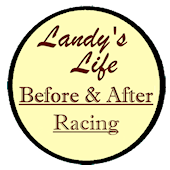



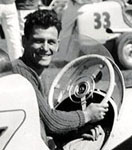 coast
to coast and the Mid-west was the hot bed of the sport. I
started where most people started in those days, stooging
for an established driver. "Stooging" was being a part of
the pit crew. Hanging out and doing whatever needed to be
done to get the car on the track. My mentor was the great
coast
to coast and the Mid-west was the hot bed of the sport. I
started where most people started in those days, stooging
for an established driver. "Stooging" was being a part of
the pit crew. Hanging out and doing whatever needed to be
done to get the car on the track. My mentor was the great
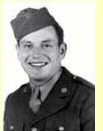 After
being discharged from the Army Air Corps in March of 1945, I
took my mustering out pay of $300.00 and bought my first
midget, "The Beeler Bar Special." It was painted green
(considered unlucky in auto racing), with the number 9 and a
four cylinder Chevy engine.
After
being discharged from the Army Air Corps in March of 1945, I
took my mustering out pay of $300.00 and bought my first
midget, "The Beeler Bar Special." It was painted green
(considered unlucky in auto racing), with the number 9 and a
four cylinder Chevy engine.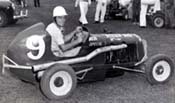 It was late in 1946 season, my first year driving. I was at
the Manitowoc County Fair, and this day was turning out no
different than many. The car was constantly developing some
sort of trouble all season long. Rods kept going out, rear
ends braking, wheels fell off, or some other sort of
problem.
It was late in 1946 season, my first year driving. I was at
the Manitowoc County Fair, and this day was turning out no
different than many. The car was constantly developing some
sort of trouble all season long. Rods kept going out, rear
ends braking, wheels fell off, or some other sort of
problem.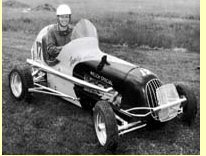 The
next race was to be at the famous Milwaukee Mile, the last
race of the season. I started last in the “Wisconsin
Class B” race. When the starter dropped the green flag,
I was in first place. The race was stopped and I got chewed
out for jumping the gun. On the second start, I took the
inside track and did the same thing. The race was halted
again, and again I got chewed out from Bill Vandewater, one
of the very best starters in the country. The third start
went off smooth and I stayed in my place. I worked myself up
to fourth place, and then hit the outside fence, which I
rode half way around the north turn before getting hung up
on a light pole. There I remained for the rest of the night.
George was the happiest guy at the track that night, just
seeing his car go. He told me that if I drove for him the
following year, he’d build a new car for me. I
agreed.
The
next race was to be at the famous Milwaukee Mile, the last
race of the season. I started last in the “Wisconsin
Class B” race. When the starter dropped the green flag,
I was in first place. The race was stopped and I got chewed
out for jumping the gun. On the second start, I took the
inside track and did the same thing. The race was halted
again, and again I got chewed out from Bill Vandewater, one
of the very best starters in the country. The third start
went off smooth and I stayed in my place. I worked myself up
to fourth place, and then hit the outside fence, which I
rode half way around the north turn before getting hung up
on a light pole. There I remained for the rest of the night.
George was the happiest guy at the track that night, just
seeing his car go. He told me that if I drove for him the
following year, he’d build a new car for me. I
agreed.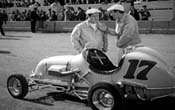
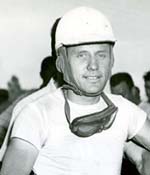 drivers and cars from throughout the country. Names such as
Tony Bettenhausen, Mike O’Halloran, Rex Easton, Paul
Russo, Myron Fohr, and Frank Berany to name a few. These
were top drivers of the day, driving the best equipment, all
powered by Offenhauser engines, designed specifically for
racing. I was driving the Studebaker powered midget of
George Welch. I surprised everyone when I qualified for the
feature event. I started from the thirteenth position and
held the spot of the entire race. With the only “stock
engine” in the field, we more than held our
own.
drivers and cars from throughout the country. Names such as
Tony Bettenhausen, Mike O’Halloran, Rex Easton, Paul
Russo, Myron Fohr, and Frank Berany to name a few. These
were top drivers of the day, driving the best equipment, all
powered by Offenhauser engines, designed specifically for
racing. I was driving the Studebaker powered midget of
George Welch. I surprised everyone when I qualified for the
feature event. I started from the thirteenth position and
held the spot of the entire race. With the only “stock
engine” in the field, we more than held our
own. relatively new and not nearly as popular as midget racing. I
drove a 1938 Ford in 12 races throughout Wisconsin, winning 11 of them.
My only loss was in a race where I rolled the
#6. After a year of driving both, midgets and stocks, I returned my focus to midgets,
besides, Stock car racing will never be successful.
relatively new and not nearly as popular as midget racing. I
drove a 1938 Ford in 12 races throughout Wisconsin, winning 11 of them.
My only loss was in a race where I rolled the
#6. After a year of driving both, midgets and stocks, I returned my focus to midgets,
besides, Stock car racing will never be successful.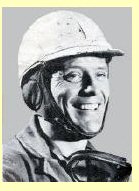 Then
in 1951 Jim Maloney and Don McGaw bought the car. I drove it
for them until 1954. In 1955, Boyd Konick, and I bought our
own car, a #7. In the meantime, McGaw got Ron Erfurth to
drive the "17". Once again, the curse of the "17" struck. In
a heat race, Erfurth flipped and went over the fence. The
car sat idle until August 1, 1955 when I bought it.
Then
in 1951 Jim Maloney and Don McGaw bought the car. I drove it
for them until 1954. In 1955, Boyd Konick, and I bought our
own car, a #7. In the meantime, McGaw got Ron Erfurth to
drive the "17". Once again, the curse of the "17" struck. In
a heat race, Erfurth flipped and went over the fence. The
car sat idle until August 1, 1955 when I bought it.